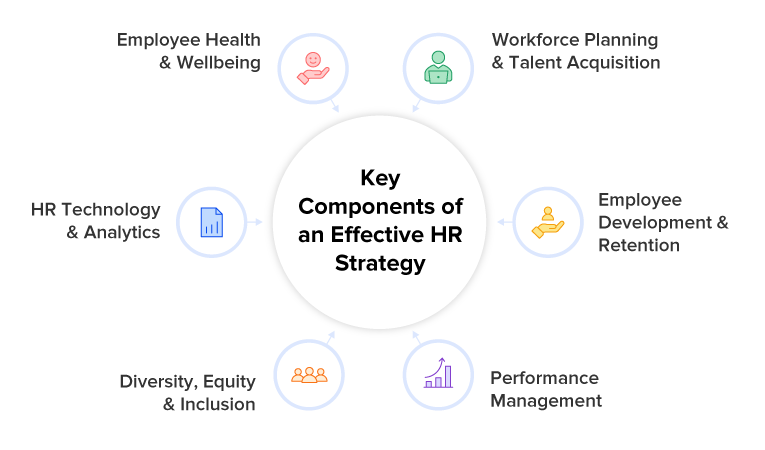What is HR Strategy? how to Create a Successful One!

Table of Contents
Nearly all organizations must manage the adverse effects resulting from misalignment in HR practices. The consequences of these practices include reduced employee engagement and overall business productivity. When HR strategies fail to align with individual and organizational goals, it can lead to confusion among employees. When an organization’s HR practices are inconsistent, employees find it difficult to understand company expectations. Misaligned HR strategies can make it challenging to achieve progress and maintain coordination.
HR strategies can be beneficial when employees are aligned with business goals. This guide will discuss why HR strategy is important and some of the key components of an effective HR strategy within an organization. We have also mentioned common challenges in HR strategies and best practices for implementing them in the organization.

What is HR Strategy?
An HR strategy is a plan that aligns the organization’s human resources (HR) practices with its business objectives. The approach enables organizations to manage their human resources effectively, thereby achieving their objectives. Businesses can reach their overall goals by developing and implementing policies and structured procedures within key strategic HR areas. These structured policies are created in areas like recruitment to hire top talent and benefits administration to retain talent. Some other methods include performance standards and code of conduct policies, which are implemented to support the business’s vision.
These policies are implemented to ensure that employees’ skills are aligned with business goals. HR strategies allow HR professionals to manage employees effectively and contribute to increased productivity. A well-structured HR strategy also improves employee experience and satisfaction.
Why is HR Strategy Important in 2026?
When HR strategies are not implemented, organizations struggle to manage their administrative tasks and achieve overall business growth. HR strategy encourages a work culture that features clear policies and a continuous learning environment, promoting high performance. Strong business strategies help organizations attract and retain top talent, as these strategies offer a competitive edge in the market.
It is advised to develop HR strategies in any organization, as it reduces turnover when employees’ skills are employed in the right direction. The policies are also created by giving importance to changes like technological advancements and workforce demographics to stay relevant in the market. Organizations can develop relevant policies to support business goals and meet the needs of a changing environment. When HR strategies are in place, organizations can avoid legal risks related to labor laws and workplace safety standards.
Key Components of an Effective HR Strategy
HR strategies differ from company to company, depending on their needs and size. However, some general policies are covered and discussed below for further information.

Workforce Planning & Talent Acquisition
A talent acquisition strategy involves identifying future talent needs, which are informed by business goals. When companies promote their work culture and values, it helps attract top talent. Organizations can target and hire individuals who can help achieve their objectives and lead the business to success.
Employee Development & Retention
HR professionals should stay updated on the business changes and help employees improve their skills to adapt to these changes. Employees can learn new skills through training and mentoring programs. A strong employee retention strategy allows organizations to build a stable work environment and a positive company culture.
Performance Management
Performance management strategies include goals and expectations for all employees. The strategy helps employees understand what is expected of them, and regular performance reviews are conducted to track their progress. These strategies are also connected to the compensation and benefits program to help motivate employees.
Diversity, Equity & Inclusion (DEI)
DEI strategies help organizations lead to a more inclusive and engaged workplace. When these policies are implemented, they can enhance employee retention and foster a sense of belonging among employees. It also brings innovation to the organization, as diverse teams work collectively to achieve results.
HR Technology & Analytics
HR technology and analytics are implemented in every modern organization, as they enable HR professionals to make data-driven decisions in HR-related areas, such as recruitment. When administrative tasks are simplified with the help of HR technology, it can improve the efficiency of HR departments. HR analytics utilizes data to identify patterns in the workforce and form strategies related to talent management and employee retention.
Employee Health and Mental Wellbeing
Employee health and mental well-being are crucial aspects that organizations must prioritize and develop strategies to address. This strategy directly impacts employees’ productivity and engagement. HR professionals can maintain a positive work environment and reduce absenteeism by prioritizing employees’ health and well-being.
Defined Organizational Culture
When HR professionals are transparent about the company’s culture and operations, they develop policies related to the code of conduct. The strategy is implemented to encourage desired behaviors from employees and office etiquette in the organizational culture.

What are the Different Types of HR Strategies?
HR strategies can be differentiated into two main types: General and specific HR strategies. General strategies guide businesses in their overall approach to managing employees, with strategies focusing on attracting and engaging them. Specific strategies focus on enhancing particular HR practices, such as talent management and employee development. Some examples of both types of strategies are mentioned below.
General strategies
- Attracting and Retaining
- Employee Engagement
- Organizational Code of Conduct
Specific strategies
- Talent Acquisition
- Employee Development
- Performance Management
- Compensation and Benefits
- Employee Engagement
- Diversity and Inclusion
- Succession Planning
- Learning and Development
- Employee Relations
- Compliance
How to Develop an HR Strategy in 7 Steps
This section outlines the steps for developing an effective HR strategy within an organization. HR professionals can consider these 7 steps to help create strategies. These are:
Plan the Strategy
Organizations should first focus on multiple internal and external factors when developing an HR strategy. Internal factors include organizational culture and employee demographics. External factors include economic conditions and technological advancements. The planning process becomes simple when important goals and objectives are documented, as it helps implement the policy.
Understand How HR Delivers Value to the Organization
To understand the impact of HR strategies, it is essential to assess how HR professionals can contribute value to the organization through these policies. The effect is measured through tracking and quantifying HR practices. This will demonstrate how HR practices can create value when combined with business goals. After this stage, the management can allocate resources appropriately to implement the strategy.
Research on Emerging Trends
The business world is constantly evolving in response to market trends and technological advancements. It is essential to research emerging trends, such as a greater focus on artificial intelligence and employee well-being. Other emerging trends include diversity, equity, and inclusion (DEI) policies and a flexible work environment. HR professionals should regularly monitor these trends and make adjustments accordingly to remain relevant in the market.
Develop a Checklist
Developing an HR strategy can be a tedious task, as it involves considering multiple aspects. There is a lot of information to include, and for this reason, it is advisable to break down the entire list into smaller sections. Categorize the checklist into small parts and create a well-structured policy.
Develop a Timeline
Organizations should prepare a timeline to set and achieve objectives. These objectives can be short-term or long-term and should be regularly assessed. The changes made should support organizations to stay relevant and adapt to the changing environment.
Be Prepared for Changes
When organizations develop strategies, they are generally for the long term. But with the changing work environment, these strategies need to be modified accordingly. Some changes should be incorporated into the policy for the better functioning of an organization. To understand this more thoroughly, take an example of a manufacturing company that is adopting a new inventory management software. Here, the company should focus on change management and provide training to employees to assess their ability to use the software effectively.
Provide Training to HR Teams
Organizations should provide training to their HR teams after identifying skill gaps. The training enables HR professionals to manage talent and gain expertise in other key aspects effectively. This expertise helps achieve business goals by analyzing current skills and bridging the gaps. Provide training and development opportunities to enhance the knowledge and skills of HR teams. It supports their career development and increases job satisfaction.

What are Common HR Strategy Challenges
Organizations face some common HR strategy challenges, which are mentioned below:
- Organizations face challenges in talent acquisition and retention, including addressing skill gaps and offering competitive compensation packages.
- Maintaining high levels of employee engagement and a positive work environment is challenging, yet crucial, as it helps increase productivity.
- Companies must regularly monitor changes in labor laws and regulations to ensure proper compliance.
- Technological advancements and digital solutions make it challenging for organizations to introduce change management.
- Organizations have to plan how to implement new strategies in the workplace, as employees may resist these policies and processes.
- Organizations often struggle to identify future leaders and effectively implement succession planning.
- It is essential to implement DEI plans in the workplace; however, sometimes the decisions made can be biased.
What are the Benefits of Strategic Human Resources Planning?
Strategic Human Resource Planning (SHRP) enables businesses to advance, offering multiple benefits. Some of the benefits are discussed below:
Achieve Organizational Goals
Strategic HR planning enables organizations to ensure that their HR goals are aligned with the overall organization’s objectives. It creates a more focused approach for HR professionals and organizations as a whole.
Attract and Retain Top Talent
HR strategy includes identifying future talent needs and acquiring the necessary talent. It helps organizations focus on their recruitment process and make changes whenever needed.
Better Succession Planning
Strategic HR planning also focuses on identifying future leaders and helping them develop their skills through training programs. Organizations, with the help of HR managers, plan for succession planning to ensure a smooth transition of leadership positions and maintain business continuity.
Cost Management
HR strategic planning allows businesses to manage their workforce costs and enhance operational efficiency. Some of the areas where costs can be reduced include recruitment and training programs.
Improved Employee Engagement
When strategies for employee engagement are implemented in an organization, it leads to a more productive and motivated workforce. For example, creating a positive workplace environment with flexible work arrangements can make employees feel valued by the organization.
Enhanced Productivity
Strategic human resource planning involves employees having the required skill sets to achieve the overall organization’s goals. The proper planning helps enhance productivity, as it increases employees’ performance. HR strategy can also help create a more motivated and skilled workforce, ultimately leading to organizational success.
Risk Management
HR strategies help identify risks, such as talent shortages or skill gaps, and take corrective actions promptly to mitigate these risks. These strategies are designed to ensure business continuity.
Improved Training and Development
The strategies can help identify skill gaps, and training programs can be scheduled to improve employees’ skills. These programs are designed to help employees enhance their performance and prepare for future roles.
Best Practices for Implementing an HR Strategy
The business market is constantly evolving, and these changes cannot be easily predicted. It is essential to remain proactive in times of challenge. The following are some best practices for implementing an HR strategy.
- The policies created must prioritize people, incorporating perspectives from various leaders and HR professionals.
- HR teams need resources to carry out their operations smoothly, and it is advisable to collaborate with finance teams to help with budgeting.
- HR professionals should work with other departments to combine individual departmental goals with organizational objectives.
- The strategy should be reviewed regularly to find changes and implement them in the policy.
- Cross-team collaboration enables companies to utilize their workforce’s skill set to the fullest and foster trust between teams.

Future Trends Shaping HR Strategy
Several emerging trends are helping organizations shape their HR strategies. These are:
Use of AI in HR
Routine HR-related processes can be automated with the use of AI. Artificial intelligence is utilized in areas such as recruitment and performance management, which can help streamline these processes.
Flexible Work Arrangements
Following the COVID-19 pandemic, companies have begun to offer flexible work arrangements, including hybrid and remote working options. When these policies are implemented in an organization, they enhance employee productivity and promote a better work-life balance.
Employee Well-Being
Companies should prioritize employee well-being, as it is a fundamental aspect of any modern business. The strategy provides mental health support and wellness programs that help employees manage stress effectively.
Continuous Learning and Development
Organizations should continuously invest in training and development programs because when employees acquire new skills, it helps achieve performance goals. This helps improve employee performance by upskilling and reskilling themselves.
Analytics and Reports
HR professionals and organizations utilize data analytics to inform decisions in various aspects of their operations. Some of these areas are talent management and employee engagement.
Diverse and Inclusive Workforce
HR professionals should focus on making the workplace more diverse and inclusive. It includes implementing practices, such as diversity, equity, and inclusion (DEI) techniques and unbiased hiring processes.
Conclusion
HR strategy is important to every organization, as there are multiple benefits of implementing these policies. These strategies are developed with consideration for the organization’s human resources (HR) goals and overall objectives. As business requirements differ, unique policies are established. Note that an effective HR strategy is essential for aligning workforce management with business growth.
factoHR’s HR software platform helps organizations simplify HR processes for informed decision-making. With its mobile-driven approach, HR professionals can manage all HR-related modules and increase overall organizational efficiency.

FAQs
What are Strategic HR Functions?
Strategic Human Resource Management (SHRM) aligns HR practices with the organization’s overall goals. It helps increase employees’ motivation and drive business performance. Some strategic HR functions are:
- Workforce Planning
- Talent Management
- Performance Management
- Compensation and Benefits
- Employee Engagement
- Change Management
- Diversity and Inclusion
What are the 5 Pillars of HR Strategy?
The pillars in HR strategy enable companies to remain compliant with various laws and align performance with business objectives. Companies practice implementing HR strategies to focus on employee well-being and increase overall productivity. These 5 pillars of HR strategy are:
- Legal compliance
- Employee Engagement
- Career Advancement
- Strong Corporate Image
- Performance Management System
How to Create an HR Strategy?
Those organizations that want to create an effective HR strategy should first focus on understanding their overall business objectives and goals. This process enables organizations to develop HR goals and concentrate on key areas, such as employee development and performance management. Once the planning process is complete and HR strategies are implemented, they should be regularly tracked to identify and implement necessary changes.
How does HR Strategy Differ from HR Management?
HR strategy is a long-term vision on how human resources can support the organization’s objectives and goals. It focuses on the overall approach and goals of the organization. HR management oversees day-to-day operations and practices that support the implementation of HR strategies and policies. It focuses on how various policies and procedures will help achieve business goals.
What is an HR Strategy Example?
There are various types of HR strategies, like
- Talent Acquisition & Management
- Compensation Planning
- Employee Development
- Learning & Development
- Strong Company Culture
Grow your business with factoHR today
Focus on the significant decision-making tasks, transfer all your common repetitive HR tasks to factoHR and see the things falling into their place.

© 2026 Copyright factoHR


